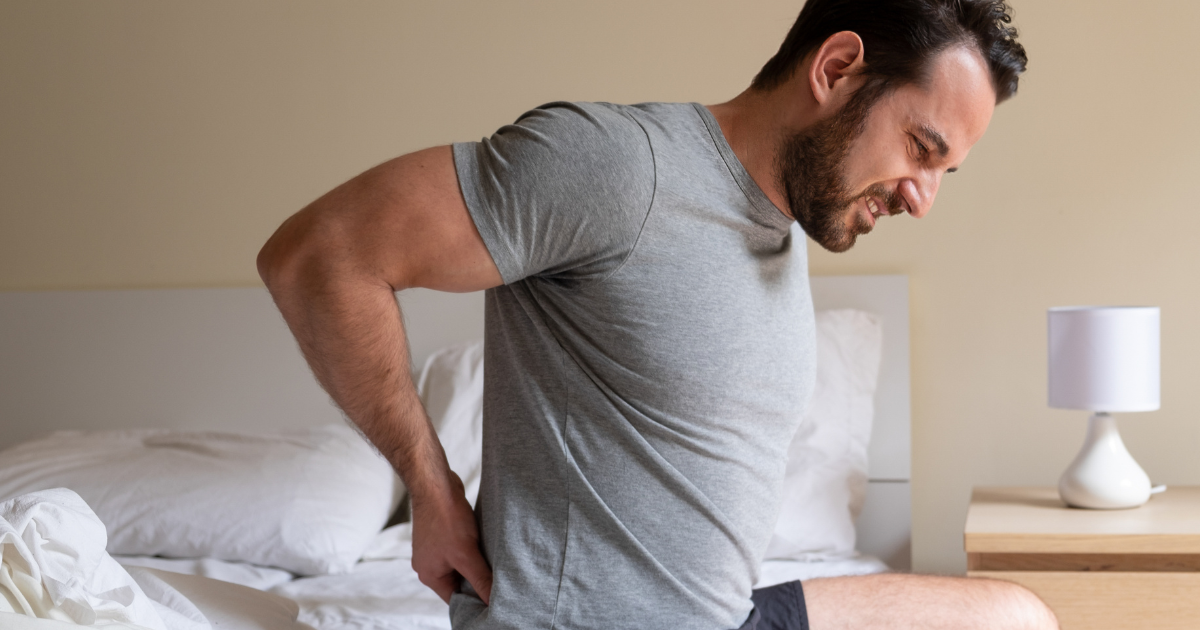How Do You Know If Back Pain is Muscular?
Key Takeaways:
- Different Types of Back Pain: Muscular, Disc-Related, Nerve-Related, Osteoarthritis, Postural.
- Identifying Muscular Back Pain: Localized pain triggered by movement, tightness, stiffness, and tenderness.
- LUMINAS Back Pain Patches: A non-invasive, drug-free pain patch providing targeted relief for muscular back pain.
- Treatment: Complement LUMINAS Back Pain Patches with medical treatments (physical therapy) and at-home remedies (Epsom salt baths, red light therapy).
- Lifestyle Tips: Adjust ergonomics, manage stress, and engage in regular movement to prevent pain.
At LUMINAS, our mission is to help you reclaim a life free from the limitations of back pain. Back pain, whether it’s a constant, dull ache or sharp, debilitating discomfort, can significantly interfere with your daily activities and overall quality of life. Understanding the root cause of your pain is crucial to finding the most effective relief.
In this blog, we’ll explore the different types of back pain, with a focus on muscular-related issues. By identifying whether your pain is due to a strained muscle, spinal pain, or nerve issues, you can make informed decisions and find the appropriate treatment. We’ll go over a few tips and also introduce how LUMINAS Back Pain Patches can provide targeted relief for muscular back pain, helping you move closer to a pain-free lifestyle.

5 Types of Back Pain
Back pain can stem from various sources, but it typically falls into one of several categories. Identifying the cause of your pain is key to finding relief.
1. Muscular Back Pain
Causes for muscular back pain include:
- Overuse or Muscle Strain: This is often due to repetitive movements, lifting heavy objects/improper lifting, or those awkward sudden movements that put stress on the back muscles.
- Poor Posture: Sitting or standing in an unnatural position for long periods can lead to muscle imbalances and strain.
- Injury: Acute injuries from sports, accidents, or falls can cause muscle tears or sprains, leading to muscular back pain.
2. Disc-Related Back Pain
Causes for disc-related back pain include:
- Herniated Discs: This occurs when the soft inner material of a spinal disc bulges out through a tear in the outer layer, pressing on nearby nerves.
- Degenerative Disc Disease: Over time, discs in the spinal cord can wear down, leading to pain as they lose their cushioning ability.
- Trauma: A sudden injury or impact can damage the intervertebral discs, leading to severe back pain and discomfort.
3. Nerve-Related Back Pain
Causes for nerve-related back pain include:
- Sciatica: When the sciatic nerve is compressed, usually by a herniated disc or bone spur, it can cause pain that radiates down the leg.
- Spinal Stenosis: The narrowing of the spinal canal can put pressure on nerves, leading to pain and other symptoms.
- Pinched Nerve: Nerves can become compressed due to various factors, including herniated discs, muscle stiffness, or bone spurs.
4. Osteoarthritis-Related Back Pain
Causes for osteoarthritis-related back pain include:
- Joint Wear and Tear: Osteoarthritis occurs when the cartilage between joints wears down over time, causing bones to rub together and lead to pain.
- Inflammation: Chronic inflammation in the joints can exacerbate pain and stiffness in the back.
- Bone Spurs: As the body attempts to repair joint damage, it may produce bone spurs, which can contribute to pain.
5. Postural Back Pain
Causes for postural back pain include:
- Chronic Poor Posture: Sitting or standing with improper alignment can lead to decreased muscle strength and strain over time.
- Weak Muscles: Muscles that are not strong enough to support the spine properly can cause postural imbalances and pain.
- Imbalanced Workstations: Poor ergonomics at work, such as improperly adjusted desks or chairs, can contribute to postural issues and back pain.
What Does Muscular Back Pain Feel Like?
If you’re wondering how you can tell if back pain is muscular or something else, there are a few key common symptoms to consider. Muscular back pain is typically localized, meaning it’s confined to a specific area, and it often feels like an ache or tightness in the muscles. Unlike nerve-related pain, which can radiate down the arms or legs, or disc-related pain, which may cause numbness or tingling, pain related to a back muscle tends to stay in the muscles themselves.
How Do You Know If Your Back Pain is Muscular?
- Pain Triggered by Movement: If your pain intensifies when you move, bend, or twist, it’s likely muscular. A back muscle that has been strained or overworked will react to movement.
- Localized Pain: Muscular pain is generally felt in a specific area of soft tissue, such as the lower back (lumbar spine) or just below your neck (trapezius/cervical spine area), rather than radiating across a broader region or along the spine specifically.
- Muscle Tightness and Stiffness: A tight or stiff back muscle are a hallmark of muscular back pain. This can lead to difficulty walking, moving freely and/or maintain a full range of motion.
- Muscle Spasms: Involuntary contractions or spasms in the back muscles can cause sharp, sudden pain.
- Tenderness to Touch: The affected area may be sensitive or painful when you press on it, indicating that the muscles are inflamed or injured.
- Note on how long the muscular pain may last: Muscle pain can last a wide-ranging amount of time, so your muscular back pain may only last a couple of hours. But for severe muscle strains, the pain could last a few days, a few weeks, or even a few months for chronic back pain. Just below we provide ways to treat muscular back pain to reduce the duration of pain being felt.
How to Treat Muscular Back Pain
Treating muscular back pain involves a combination of approaches, depending on the severity of your symptoms and how they affect your daily life.
1. LUMINAS Back Pain Patches: Your Go-To for Targeted Relief
Our patches offer targeted pain relief specifically designed for muscular back pain. Here’s how they can help:
- Targeted Pain Relief: The patches are designed to be placed directly on the area of pain, providing relief where it’s needed most.
- Natural and Non-Invasive: LUMINAS Back Pain Patches are drug-free, making them a safe alternative to traditional pain relievers.
- Long-Lasting Support: Each patch delivers pain relief that lasts throughout the day, allowing you to stay active and comfortable.
- Complementary and Convenient: These patches can be easily incorporated into your daily routine alongside other treatments or therapies.
2. Advanced Treatments for Back Pain
For more persistent or long lasting pain, medical treatments may be necessary:
- Physical Therapy: A physical therapist can provide an accurate diagnosis of your issue and guide you through exercises that strengthen the back muscles and improve flexibility.
- Trigger Point Injections: These injections can help relieve pain and reduce inflammation in specific areas.
- Dry Needling: This technique involves inserting thin needles into trigger points to release muscle tension and reduce pain.
3. At-Home Healing: Simple Strategies for Muscle Relief
There are several self-care strategies you can try at home to alleviate muscular back pain:
Note: Always consult a medical professional if you are experiencing significant pain or discomfort.
- Epsom Salt Baths: Soaking in a warm bath with Epsom salts can help relax tense muscles and reduce soreness.
- Soft Tissue Myofascial Release: Myofascial release therapy is a type of gentle, constant massage that releases tightness and pain throughout your myofascial tissues.
- Over-the-Counter Pain Relievers: Non-prescription pain relievers, such as ibuprofen or acetaminophen, can help manage pain and inflammation, although can have detrimental side effects.
- Red Light Therapy: Red and infrared light therapy emits extremely beneficial light energy to activate the body’s natural healing response at the cellular level for lasting relief from pain.
4. Healthy Habits: Lifestyle Tips for a Healthier, Stronger Back
Making a few adjustments to your daily habits can also make a big difference:
- Ergonomic Adjustments: Ensure your workspace is set up to support good posture and reduce strain on your back. Standing more often throughout the day, not slouching, and taking brief walks to break up extended periods of sitting are all great ways to ensure you are more ergonomically positioned throughout the day.
- Stress Management: High levels of stress can contribute to muscle tension, so finding ways to relax is essential. Reading, meditating, listening to soothing music, and breathwork exercises are all great ways to reduce stress.
-
Regular Movement: Regular physical activity, like walking, swimming, lifting weights, or yoga, helps keep your back muscles strong but also flexible, reducing the risk of injury. Engaging in low-impact exercises that strengthen the core muscles and back muscles can be particularly beneficial for preventing back pain.

5. The Last Resort: Surgical Interventions
In rare cases, surgical interventions may be necessary, especially if muscular pain is accompanied by other issues like nerve compression. However, this is typically a last resort.
The Finish Line to Pain-Free Living
Living with back pain doesn’t have to be your reality. By understanding the type of pain you’re experiencing and exploring the right treatment options, you can find relief and get back to doing the things you love. Whether you’re managing mild discomfort or more severe pain, LUMINAS Back Pain Patches offer a natural, non-invasive solution that can support your journey to pain-free living. Don’t let back pain hold you back—take control and start feeling better today!
Get Your LUMINAS Back Pain Relief Patches Today
When to Consider Professional Treatment
While some cases of back pain can be managed with self-care and over-the-counter remedies, there are certain situations where seeing a healthcare professional is necessary. It’s important to be aware of the red flags that indicate a more serious underlying issue.
Red Flags to Watch Out For:
- Worsening Pain that Doesn’t Improve: If your back pain is intense and doesn’t get better with rest or treatment, it could be a sign of a more serious condition.
- Pain Accompanied by Fever: A fever along with back pain could indicate an infection or other serious issue that requires immediate medical attention.
- Loss of Bladder or Bowel Control: This is a medical emergency and could indicate cauda equina syndrome, a serious condition that requires prompt treatment.
- Unexplained Weight Loss: If you’re losing weight without trying and experiencing back pain, it could be a sign of a serious condition, such as cancer.
- Numbness, Tingling, or Weakness: These symptoms, particularly if they radiate down the legs or arms, suggest nerve involvement and require a professional evaluation.
- Pain After Trauma: If you experience back pain after an accident, fall, or other trauma, it’s essential to seek medical attention.









